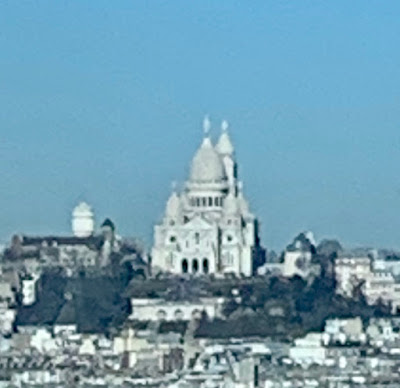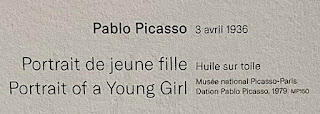One of Paris' finest museums is the National Picasso Museum . . . normally. The museum was founded in 1985 and it has very large collection of the artwork of Pablo Picasso (1881-1973), who lived most of his life in France. The collection was given to France in lieu of paying France's very steep inheritance taxes following the artist's death.
We visited the museum earlier in Year 4 when it was hosting a temporary exhibition, which featured works of Alexander Calder and Pablo Picasso.

The premise of the exhibition is that the two artists explored the same theme in different ways. According to the museum: "Alexander Calder [1898-1976] and Pablo Picasso – two of the most seminal figures of twentieth-century art – innovated entirely new ways to perceive grand themes. While the resonances between them are filled with endless possibilities, a key connection can be found specifically in their exploration of the void, or the absence of space, which both artists defined from the figure through to abstraction. Calder and Picasso wanted to present or represent non-space, whether by giving definition to a subtraction of mass, as in Calder’s sculpture, or by expressing contortions of time, as in Picasso’s portraits. *** The exhibition will comprise approximately 120 works that explore how these two artists, each in his own very different way, engaged with the void and all that it implies about a world where mass is unsettled by the absence of mass and where, at the center of anything and everything, what we discover is a vacuum." (From MuseepicassoParis.fr.)
Our take on it --
The two artists, who first met in 1931, were not friends and did not collaborate artistically. So, in our opinion, the premise of the exhibition was a bit strained. After viewing the exhibition, our opinion was the same. We concluded that the exhibition was intended to leverage Calder's name to drive higher attendance. Throughout the exhibit, there was a noticeable absence of explanatory information or documentation to support the curator's bold premise. We were underwhelmed.
The two artists, who first met in 1931, were not friends and did not collaborate artistically. So, in our opinion, the premise of the exhibition was a bit strained. After viewing the exhibition, our opinion was the same. We concluded that the exhibition was intended to leverage Calder's name to drive higher attendance. Throughout the exhibit, there was a noticeable absence of explanatory information or documentation to support the curator's bold premise. We were underwhelmed.
Here is a sampling of the Picasso and Calder works included in the exhibition. We leave it you to decide they were independently exploring the same theme--the void.
 |
| Joséphine Baker (IVI Danse by Alexander Calder (1928) |
Let us know if you saw the void in the works pictured above.
The exhibition occupied a large portion of the medium-sized museum. Consequently, many of the Picasso works normally displayed in the main galleries were instead placed in storage or lent to other museums. So, the normally fine National Picasso Museum was quite disappointing because many pieces were absent.
Fortunately, a few of the galleries upstairs were undisturbed by the mediocre exhibition and featured some great works by Picasso, like the Cubist painting below.
In case you want to see a photograph of the painting's subject, here it is.
 |
| Le Sacré-Cœur |


















No comments:
Post a Comment